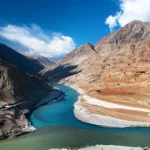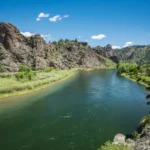
The Congo River, which flows through Africa, is both the world’s deepest and second-largest river. The Congo River is also known as the Zaire River. Lake Tanganyika, Lake Mweru, the East African Rift, and the Chambeshi River are the river’s main sources. It starts at the confluence of the Lualaba and Luvua rivers. The Congo River is the world’s eighth longest river, stretching 2,914 miles and ranging in width from half a mile to ten miles. Because of its proximity to the Equator, the Congo River supports a diverse range of wildlife in the tropical rain forest as well as grazing land along its banks. The Congo River’s water is home to a diverse range of animals, and many people live along its banks, relying on fish for food and water for crop irrigation.
Diego Cao was the first known European explorer to see and enter the Congo River in 1482.
The Kongo Kingdom inspired the name of the Congo River. This kingdom was situated near the Congo River’s mouth.
Joseph Conrad dubbed the Congo River the “Heart of Darkness.” The Congo River and the rainforest along its banks have been portrayed in history as being full of cannibals, pygmies, horrible plagues, and strange beasts.
The Congo River is thought to have formed 1.5 to 2 million years ago. This was during the Pleistocene epoch.
The Congo River has a section known as “The Gates of Hell.” It’s a 75-mile stretch of rapids.
Tribal warfare, slavery, ivory harvesting, and ethnic massacres have all plagued the people and land along the Congo River, and they continue to this day.
The Congo River flows through Tanzania, Cameroon, Zambia, Angola, Zaire, and the Republic of Congo in Africa.
Novosobirsk, Barnaul, Mogochin, and Akademgorodok are among the major cities through which the Congo River flows.
The Congo River’s main tributaries are the Kasai, Sangha, and Ubangi.
The Congo River discharges 1,500,000 cubic feet per second into the Atlantic Ocean. Because at least one section of the river is always in flood, the water flow is fairly consistent throughout the year.
The Congo River is Africa’s second longest river. The Nile River is the first.
Although many people associate Africa with being hot and dry, the Congo River receives approximately 90 inches of rain per year.
For hundreds of years, the Congo River has served as a major mode of transportation for Africans. There are still few roads and railways, and the river serves as the primary mode of transportation in the region.
The Congo River’s water is used to irrigate crops such as cotton, sugarcane, and tobacco by the people who live along its banks.
Although it is used for transportation, the Congo River contains sections that are impossible to navigate, such as rapids, waterfalls, and numerous islands (approximately 4,000 islands).
There have been approximately 700 species of fish discovered in the Congo River’s waters, but many more are believed to exist. Many animals, including giraffes, gazelles, zebras, buffalo, and antelope, rely on the Congo River for food.
FAQs about the Congo River
Here are some frequently asked questions about the Congo River, answered in detail:
- How long is the Congo River?
The answer depends on how you measure it!
- If you consider the entire Congo-Lualaba-Luvua-Luapula-Chambeshi River system, it stretches for an impressive 4,700 kilometers (2,900 miles), making it the world’s ninth-longest river.
- Focusing just on the Congo River itself (excluding the Lualaba section), the length is around 4,370 kilometers (2,720 miles).
- Compared to other African rivers, it’s the second longest after the Nile.
- How powerful is the Congo River?
The Congo River is a mighty force. Here’s why:
- Discharge volume: It’s the world’s third-largest river by discharge volume, pouring a staggering 1,500,000 cubic feet of water per second into the Atlantic Ocean. Imagine that!
- Depth: It holds the record for the deepest river ever recorded, with depths exceeding 220 meters (720 feet) in some areas.
- Uniqueness: It’s the only major river to cross the equator twice, making its journey through the heart of Africa truly exceptional.
- What is the Congo Basin like?
The Congo Basin, drained by the river, is vast and diverse:
- Size: It covers a massive area of approximately 4,000,000 square kilometers (1,500,000 square miles), encompassing 13% of Africa’s landmass.
- Rainforest Haven: It’s home to the second-largest rainforest in the world, surpassed only by the Amazon rainforest. This creates a hot and humid climate with abundant rainfall.
- Diverse Ecosystem: The basin boasts a rich tapestry of life. From towering trees and lush undergrowth in the rainforest to savannas bordering the edges, it provides a habitat for countless species of birds, fish, mammals like hippos and crocodiles, and many more.
- What is the Congo River’s importance?
The Congo River plays a vital role in Africa:
- Transportation: It forms a navigable waterway over 14,480 kilometers (9,000 miles) long, facilitating trade of goods like copper, sugar, and palm oil.
- Hydropower: It’s a powerhouse for hydroelectric potential, with the Livingstone Falls powering the Inga Dam, a major source of electricity.
- History: The river has played a significant role in the history of the region, shaping settlements and serving as a trade route.
- Are there any interesting facts about the Congo River?
There sure are! Here are a few:
- Geological connection: Some geologists believe the Congo may have once been linked to the Amazon River as part of a massive prehistoric river system when the continents were joined.
- Exploration Challenges: The Congo’s immense size and series of rapids made exploration difficult for centuries, adding to its mystique.
These are just a few of the many fascinating aspects of the Congo River. It’s a powerful force of nature, a vital resource, and a place of incredible biodiversity.









